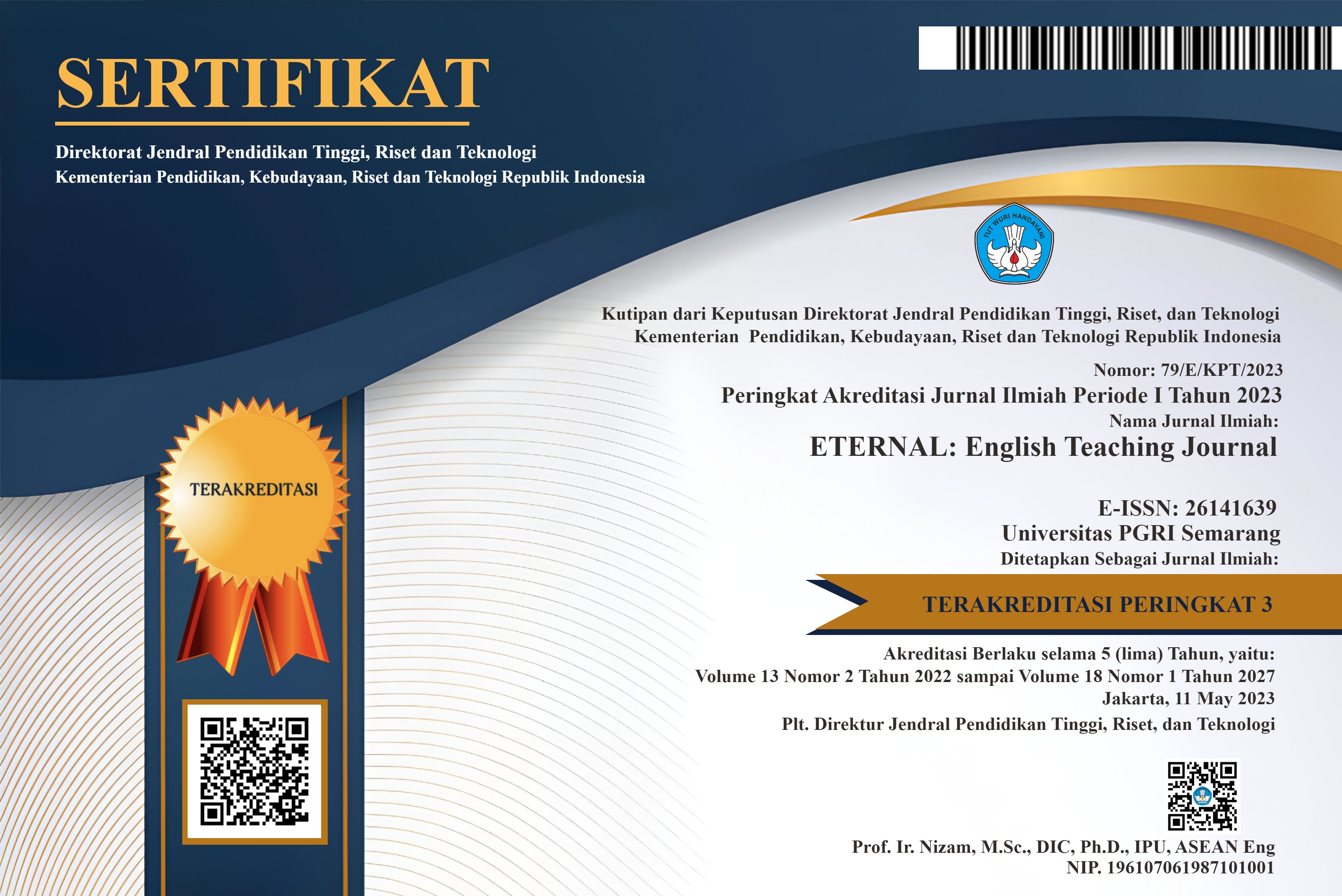Developing Animated Video of Describing People for Vocabulary Learning
DOI:
https://doi.org/10.26877/eternal.v15i2.475Keywords:
Development, Animated Video, Describing People, VocabularyAbstract
This study aims to develop an animated learning video on describing people. The subjects of this study were first-year students majoring in English education at Riau University, totaling 39 students. The researchers applied Research and Development (R&D) by applying the ADDIE model. The instruments used were interviews, validation sheets from media experts, material experts, and pedagogic experts, and student response questionnaires. The results showed that the average results of the experts' assessment for animated videos with idioms for describing people material were 92.4% which was classified as 'highly valid' and for animated videos with material describing people; personality was 93% which was classified as 'highly valid', then from the results of student response questionnaires obtained a percentage score of 80.66% categorized as 'feasible' for video animations with idioms for describing people material and 79.22% categorized as 'feasible' for video animations with material describing people; personality. Therefore, the video animation is declared valid and feasible to be used as vocabulary learning media for English language education students. In addition, the use of animated video learning media describing people can have a positive impact on learning activities, namely attracting students' interest in learning and helping students understand the material.
References
Ahdan, S., Putri, A. R., & Sucipto, A. (2020). Aplikasi m-learning sebagai media pembelajaran conversation pada homey english. Sistemasi, 9(3), 493. https://doi.org/10.32520/stmsi.v9i3.884
Akbar, S. (2013). Intrumen Perangkat Pembelajaran. Jakarta.
Al-Ghasab, G. B. (2022). Reality of using modern teaching methods in teaching english language among teachers. International Journal of Education in Mathematics, Science and Technology, 10(2), 512–527. https://doi.org/10.46328/IJEMST.2291
Aljaraideh, Y. A. (2020). The impact of digital storytelling on academic achievement of sixth grade students in english language and their motivation towards it in jordan. Turkish Online Journal of Distance Education, 21(1), 73–82. https://doi.org/10.17718/tojde.690345
Almalki, A. (2020). Integration of technology among saudi EFL teachers. English Language Teaching, 13(8), 160. https://doi.org/10.5539/elt.v13n8p160
Bulan, A., & Idhar, I. (2021). Developing noun words domino card (NWDC) learning media to improve english vocabulary mastery of junior high school students. VELES Voices of English Language Education Society, 5(2), 192–205. https://doi.org/10.29408/veles.v5i2.4028
Cabrera, P., & Ulehlova, E. (2017.). Exploring the use of educational technoogy in EFL teaching : A case study of primary educatation in the south region of ecuador. Teaching English with Technology, 17(2), 77–86.
Hapsari, Gita Permata Puspita., & Z. (2021). Analysis of the needs of animated video media based on the canva application in science. Pancasakti Science Education Journal, 6(1), 22–29. https://doi.org/10.24905/psej.v6i1.43
Lu, L., & Sides, M. L. C. (2022). Instructional design for effective teaching: The application of ADDIE model in college reading lesson. NOSS Practitioner to Practitioner SPRING 2022, (2), 4–12.
Maryanti, S., & Kurniawan, D. T. (2018). Pengembangan media pembelajaran video animasi stop motion untuk pembelajaran biologi dengan aplikasi picpac. Jurnal BIOEDUIN : Program Studi Pendidikan Biologi, 8(1), 26–33. https://doi.org/10.15575/bioeduin.v8i1.2922
Maya, Y., & Saragih, E. (2021). The utilization of animation in the theory of procedure text writing for VI-grade SD methodist-2 Medan students. Advances in Language and Literary Studies, 12(2), 70. https://doi.org/10.7575/aiac.alls.v.12n.2.p.70
Nerissa, M., Pulungan, A. H., & Erlita, Y. (2020). Developing media based on powtoon in teaching writing recount text for grade VIII students in Smp Muhammadiyah 1 Medan. REGISTER: Journal of English Language Teaching of FBS-Unimed, 8(3). https://doi.org/10.24114/reg.v8i3.20896
Ningsih, S. K., Suherdi, D., & Purnawarman, P. (2022). Secondary school teachers' perceptions of mobile technology adoption in english as a foreign language learning: Trends and practices. International Journal of Education and Practice, 10(2), 160–170. https://doi.org/10.18488/61.v10i2.3004
Pujiani, T., & Almustaflikhah, N. (2022). The development of animation videos for teaching english integrated skills for young learners. LEAD (Language, Education and Development), 2(1), 9. https://doi.org/10.20884/1.lead.2022.2.1.5490
Purwanti, I. T., Suryawati, E., & Eliwarti. (2022). Video lectures in online EFL flipped-classroom: effectiveness, students’ evaluation and experiences. European Journal of Educational Research, 11(2), 885–898. https://doi.org/10.12973/EU-JER.11.2.885
Samosa, P. R. C., Vicente, P. L. E., Rapada, R. M., Javier, R. U., & Lansangan, I. L. M. (2021). Animated video story as innovative to improve grade 3 learners ’ story writing skills. International Journal of Academic Multidisciplinary Research (IJAMR), 5(12), 1–12.
Sultan Alshraideh, D. (2021). EFL learners’ and teachers’ perception toward the use of online videos in EFL classes. Arab World English Journal, 12(1), 215–228. https://doi.org/10.24093/awej/vol12no1.15
Vu, D. Van. (2021). Education sciences vocabulary in english language learning , teaching , and testing in Vietnam : A Review.
Woods, K., Gomez, M., & Arnold, M. G. (2019). Using social media as a tool for learning in higher education. International Journal of Web-Based Learning and Teaching Technologies, 14(3), 1–14. https://doi.org/10.4018/IJWLTT.2019070101
Yawiloeng, R. (2020). Second language vocabulary learning from viewing video in an EFL classroom. English Language Teaching, 13(7), 76. https://doi.org/10.5539/elt.v13n7p76
Yulia, A., Joshi, R. M., Husin, N. A., & Rahim, S. A. (2023). Enhancing english proficiency through social circle and vocabulary among Malaysian adult learners. Studies in English Language and Education, 10(1), 322–336. https://doi.org/10.24815/siele.v10i1.25740
Yusoff, Z. S., Gurmani, M. T. A. A., Sanif, S., & Noor, S. N. F. M. (2022). The effect of mobile-assisted CEFR english vocabulary profile word lists on L2 students’ vocabulary knowledge. Asian Journal of University Education, 18(2), 526–543. https://doi.org/10.24191/ajue.v18i2.18159







